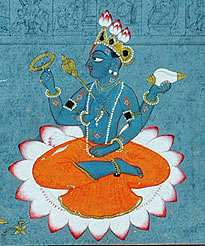Brahma Sampradaya
| Part of a series on |
| Vaishnavism |
|---|
 |
|
Sampradayas |
|
Philosophers–acharyas |
|
Related traditions |
|
|
| Part of a series on | ||
| Hindu philosophy | ||
|---|---|---|
 | ||
| Orthodox | ||
|
|
||
| Heterodox | ||
|
|
||
|
||
The Brahma Sampradaya (Brahma-sampradāya) refers to the disciplic succession (sampradaya) of gurus starting with Brahma in Hinduism.[1] The term is most often used to refer to the beliefs and teachings of Madhvacharya[2] and his Dvaita philosophy.
The term Brahma-Madhva-Gaudiya Vaisnava Sampradaya is used to refer to the teachings of Chaitanya Mahaprabhu and his Gaudiya theology..[3]
Sampradaya
Followers of this tradition believe that Vedic knowledge descends from Brahma. In the Vedic conception, these sampradayas began at the creation of the universe and endure to the present moment in the person of the student's own guru. Due to the consistency of the transmission of knowledge, all the previous gurus are present in the teachings of the present spiritual master. The Vedic process assures that the transmission remains pure by assuring the qualifications of the transmitter.[4]
List of the Sampradaya members, acharyas, beginning with Krishna Himself:
- Krishna
- Brahma
- Narada Muni
- Vyasadeva
- Madhvacarya
- Padmanabha Tirtha
- Narahari Tirtha
- Madhava Tirtha
- Aksobhya Tirtha
- Jaya Tirtha
- Jnanasindhu Tirtha
- Dayanidhi Tirtha
- Vidyanidhi Tirtha
- Rajendra Tirtha
- Jayadharma Tirtha
- Purusottama Tirtha
- Brahmanya Tirtha
- Vyasa Tirtha
- Lakshmipati Tirtha
- Madhavendra Puri
- a) Isvara Puri, b) Nityananda Prabhu, c) Advaita Acharya
Gaudiya Vaishnavism continues:
- Sri Caitanya Mahaprabhu
- a) Rupa Goswami, b) Sanatana Goswami, c) Svarupa Damodara Goswami
- a) Raghunatha dasa Goswami, b) Jiva Goswami
- Krishnadasa Kaviraja Goswami
- Narottama dasa Thakura
- Visvanatha Cakravarti Thakura
- a) Baladeva Vidyabhusana, b) Jagannatha dasa Babaji
- Bhaktivinoda Thakura
- Gaurakisora dasa Babaji
- Bhaktisiddhanta Sarasvati Thakura
- A. C. Bhaktivedanta Swami Prabhupada (Founder-Acharya of ISKCON)
- ISKCON guru system
See also
References
- ↑ Hinduism and Buddhism: An Historical Sketch - Page 239 Charles Eliot, 1998
- ↑ The Sadhus and Indian Civilisation - Page 57 Vijay Prakash Sharma - Sadhus - 1998 - 209 pages
- ↑ Female Ascetics in Hinduism Lynn Teskey Denton, 2004 - 224 pages
- ↑ Goswami, S.D. (1976), Readings in Vedit Literature: The Tradition Speaks for Itself, [S.l.]: Assoc Publishing Group, pp. 240 pages, ISBN 0912776889 Check date values in:
|year= / |date= mismatch(help)